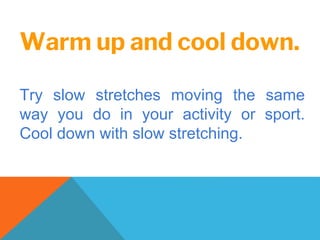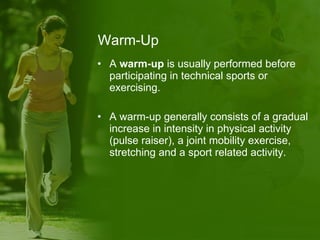A well-rounded exercise routine goes beyond just the workout itself. This comprehensive guide delves into the essential components of warm-up, cool-down, and injury prevention to ensure you get the most out of your fitness regimen. Discover the importance of warming up with various techniques and exercises tailored to different workouts. Learn effective cool-down strategies and key exercises to aid in recovery. Understand common injury risks and how to avoid them, ensuring a safe and productive exercise experience. By integrating these crucial elements into your routine, you can enhance performance, prevent injuries, and promote overall well-being.
Join zopmj.com for an in-depth exploration of this topic.
1. Importance of Warm-Up: Benefits and Techniques
Warming up is a crucial part of any exercise routine, preparing your body for the physical demands ahead. It elevates your heart rate, increases blood flow to muscles, and enhances flexibility, reducing the risk of injuries. A proper warm-up also mentally prepares you, improving focus and performance.
The benefits of warming up are manifold. It gradually increases body temperature, which optimizes muscle function and efficiency. Enhanced circulation ensures that muscles receive more oxygen and nutrients, reducing muscle stiffness and the likelihood of strains. Additionally, a good warm-up can improve joint range of motion, making movements smoother and more effective.
Several techniques can be employed for an effective warm-up. Dynamic stretching, which involves moving parts of your body through a full range of motion, is highly recommended. Activities such as arm circles, leg swings, and torso twists fall into this category. Light cardiovascular exercises, like jogging or jumping jacks, are also beneficial, as they increase heart rate and circulation. Incorporating sport-specific drills can further prepare your body for the movements required in your workout, ensuring you start your exercise session primed and ready for optimal performance.
2. Essential Warm-Up Exercises for Different Workouts

Different workouts require specific warm-up exercises to target the relevant muscle groups and movements. For cardiovascular workouts, start with light aerobic activities such as brisk walking or slow jogging for five to ten minutes to gradually increase your heart rate. Incorporate dynamic stretches like high knees, butt kicks, and arm swings to prepare your body for more intense activity.
Strength training sessions benefit from a warm-up that includes both general and specific exercises. Begin with light cardio to get your blood flowing, then move on to dynamic stretches such as lunges with a twist, leg swings, and arm circles. Follow this with lighter sets of the exercises you plan to perform, using reduced weight to practice proper form and activate the muscles you’ll be working.
For flexibility or yoga sessions, focus on gentle movements and stretches that gradually increase in intensity. Start with cat-cow stretches, gentle twists, and shoulder rolls to loosen up the spine and joints, preparing your body for deeper stretches and poses.
3. Effective Cool-Down Strategies: Why They Matter

Cooling down is an essential component of any workout routine, helping your body transition from intense activity to a state of rest. This process aids in gradually lowering your heart rate and breathing, preventing dizziness or fainting that can result from a sudden stop. It also helps in dispersing lactic acid buildup in the muscles, reducing the risk of stiffness and soreness.
Effective cool-down strategies include a combination of light aerobic activity and static stretching. Begin with five to ten minutes of low-intensity exercises such as walking or gentle cycling. This helps maintain blood flow to the muscles, aiding in the removal of metabolic waste products.
Following light aerobic activity, engage in static stretching to enhance flexibility and promote muscle relaxation. Hold each stretch for 20-30 seconds, focusing on major muscle groups used during the workout. Incorporate stretches like hamstring stretches, calf stretches, and shoulder stretches. Cool-downs not only aid physical recovery but also provide a mental transition, allowing you to reflect on your workout and plan for future sessions.
4. Key Cool-Down Exercises to Aid Recovery
To ensure a thorough cool-down, it’s important to incorporate key exercises that aid recovery and promote flexibility. Start with light aerobic activity, such as five to ten minutes of slow walking or gentle cycling, to gradually decrease your heart rate and maintain blood flow to the muscles.
Next, focus on static stretching exercises. Begin with the hamstring stretch: sit on the ground with one leg extended and the other bent, reaching towards your toes to stretch the back of your thigh. Hold for 20-30 seconds, then switch legs. Follow with the calf stretch: stand facing a wall, place one foot behind you with the heel flat, and lean into the wall to stretch the calf muscle. Hold and switch sides.
For the upper body, incorporate shoulder stretches: bring one arm across your chest, using the opposite hand to press the arm towards you, stretching the shoulder. Hold and repeat on the other side. Include the triceps stretch by lifting one arm overhead, bending at the elbow, and using the opposite hand to gently push the elbow back, stretching the triceps.
Finish with a gentle spinal twist: lie on your back, bring one knee across your body towards the opposite side, and extend the other arm out to the side, holding the twist. This sequence of exercises helps relax muscles, reduce stiffness, and enhance overall recovery.

5. Injury Prevention: Common Risks and How to Avoid Them
Preventing injuries during exercise is crucial for maintaining long-term fitness and avoiding setbacks. Understanding common risks and taking proactive steps to mitigate them can make a significant difference in your workout safety and effectiveness.
One of the most common risks is improper technique, which can strain muscles and joints. To avoid this, ensure you are using correct form by consulting a fitness professional or using reputable instructional videos. Start with lighter weights or lower intensities to master the movements before progressing.
Overtraining is another significant risk, leading to fatigue, muscle strain, and burnout. It’s essential to listen to your body and incorporate rest days into your routine to allow for recovery. Varying your workouts can also prevent overuse injuries by ensuring no single muscle group is disproportionately stressed.
Inadequate warm-up and cool-down routines are frequent culprits in exercise-related injuries. Skipping these can lead to muscle stiffness and decreased flexibility, increasing the likelihood of strains and sprains. Always begin with a proper warm-up and end with a cool-down session, as previously detailed.
Wearing inappropriate footwear can contribute to injuries, particularly in activities like running or aerobics. Choose shoes that provide adequate support and are suitable for your specific exercise type. Additionally, staying hydrated and maintaining proper nutrition supports muscle function and overall health, further reducing injury risks.
By addressing these common risks with preventive measures, you can enhance your workout experience and achieve your fitness goals safely.

6. Integrating Warm-Up, Cool-Down, and Injury Prevention into Your Routine
Integrating warm-up, cool-down, and injury prevention into your exercise routine is essential for maximizing performance and ensuring long-term health. Start each workout with a dedicated warm-up session to prepare your body for physical activity. Begin with light aerobic exercises like jogging or brisk walking for five to ten minutes, followed by dynamic stretches specific to your workout type. This approach primes your muscles and joints, enhancing your readiness and reducing injury risk.
After completing your workout, transition into a cool-down phase. Perform light aerobic activity for five to ten minutes to gradually lower your heart rate, then engage in static stretching to improve flexibility and reduce muscle stiffness. Focus on major muscle groups worked during your session, holding each stretch for 20-30 seconds.
Incorporate injury prevention strategies by ensuring proper technique in all exercises, avoiding overtraining, and using appropriate footwear. Listen to your body and allow for rest days to facilitate recovery. By consistently applying these practices, you’ll support better performance, reduce the risk of injuries, and promote overall fitness and well-being.
Incorporating effective warm-up and cool-down practices, along with injury prevention strategies, is crucial for optimizing your exercise routine and ensuring long-term health. By properly preparing your body before workouts, easing it back afterward, and addressing potential risks, you enhance performance and reduce the likelihood of injuries. Embrace these practices to achieve better results, maintain your fitness journey, and support overall well-being.
zopmj.com
zopmj.com

